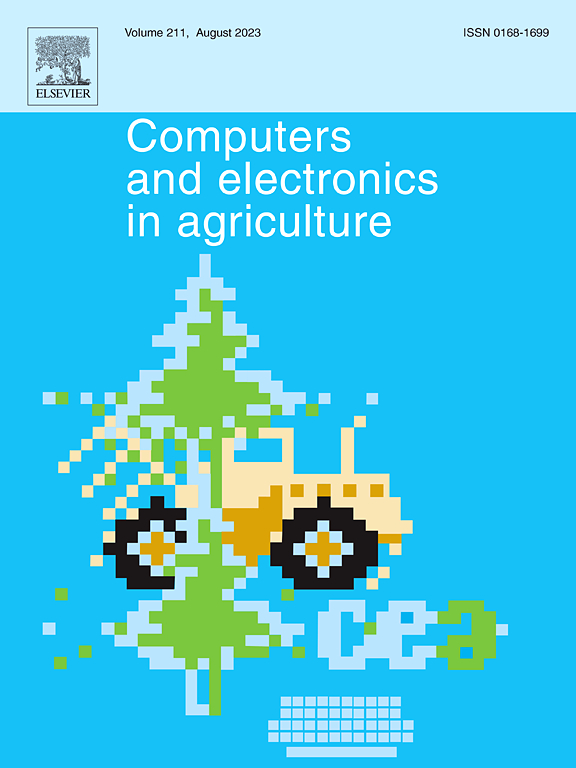无人机图像中基于深度学习的槲寄生检测硬件性能分析
IF 8.9
1区 农林科学
Q1 AGRICULTURE, MULTIDISCIPLINARY
引用次数: 0
摘要
深度学习(DL)在计算机视觉和生态数据分析等应用中已经不可或缺,在这些应用中,及时和准确的见解可以显著影响环境保护和农业生产力。槲寄生等入侵物种通过削弱宿主树木、减少生物多样性和损害生态系统服务,对林业和商业农业构成全球性威胁。本研究评估了训练卷积神经网络(cnn)检测无人机(UAV)图像中槲寄生的各种硬件配置的性能。使用ResNet-34架构,我们比较了四种平台:高性能工作站(HiPWS),英特尔中档台式机(MRD-Intel), AMD中档台式机(MRD-AMD)和消费级笔记本电脑(CGL)。记录了配置、训练和验证时间等指标,以评估跨配置的计算效率,包括超线程(HT)和虚拟化的影响。结果表明,在所有平台上禁用HT可以持续减少训练时间,特别是对于非cgl设置。虽然HiPWS在cpu密集型任务中表现出色,但CGL在短期工作负载上展示了卓越的GPU性能。重要的是,像MRD-AMD这样具有成本效益的解决方案被证明能够处理适度的训练任务,而不会造成显著的性能损失。这些发现为优化农业和林业的DL工作流程提供了可行的见解,促进了可扩展和可持续解决方案的开发,以检测和减轻全球入侵物种。本文章由计算机程序翻译,如有差异,请以英文原文为准。

Hardware performance analysis for deep learning-based mistletoe detection in UAV imagery
Deep learning (DL) has become indispensable in applications like computer vision and ecological data analysis, where timely and accurate insights can significantly impact environmental conservation and agricultural productivity. Invasive species, such as mistletoe, pose a global threat to forestry and commercial agriculture by weakening host trees, reducing biodiversity, and impairing ecosystem services. This study evaluates the performance of various hardware configurations for training convolutional neural networks (CNNs) to detect mistletoe in Unmanned Aerial Vehicle (UAV) imagery. Using a ResNet-34 architecture, we compare four platforms: High-Performance Workstation (HiPWS), Mid-Range Desktop with Intel (MRD-Intel), Mid-Range Desktop with AMD (MRD-AMD), and Consumer-Grade Laptop (CGL). Metrics such as configuration, training, and validation times were recorded to assess computational efficiency across configurations, including the impact of hyperthreading (HT) and virtualization. Results indicate that disabling HT consistently reduced training times across all platforms, particularly for non-CGL setups. While HiPWS excelled in CPU-intensive tasks, CGL demonstrated superior GPU performance for short-term workloads. Importantly, cost-effective solutions like MRD-AMD proved capable of handling moderate training tasks without significant performance trade-offs. The findings offer actionable insights for optimizing DL workflows in agriculture and forestry, facilitating the development of scalable and sustainable solutions to detect and mitigate invasive species globally.
求助全文
通过发布文献求助,成功后即可免费获取论文全文。
去求助
来源期刊

Computers and Electronics in Agriculture
工程技术-计算机:跨学科应用
CiteScore
15.30
自引率
14.50%
发文量
800
审稿时长
62 days
期刊介绍:
Computers and Electronics in Agriculture provides international coverage of advancements in computer hardware, software, electronic instrumentation, and control systems applied to agricultural challenges. Encompassing agronomy, horticulture, forestry, aquaculture, and animal farming, the journal publishes original papers, reviews, and applications notes. It explores the use of computers and electronics in plant or animal agricultural production, covering topics like agricultural soils, water, pests, controlled environments, and waste. The scope extends to on-farm post-harvest operations and relevant technologies, including artificial intelligence, sensors, machine vision, robotics, networking, and simulation modeling. Its companion journal, Smart Agricultural Technology, continues the focus on smart applications in production agriculture.
 求助内容:
求助内容: 应助结果提醒方式:
应助结果提醒方式:


